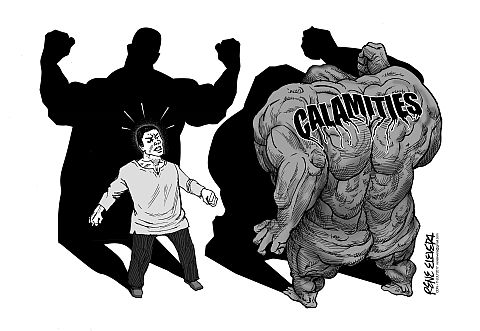Yesterday’s aftershock — which registered an Intensity III in Cebu City, Intensity II in Lapu-Lapu City and Intensity IV in Mandaue City — was an unwelcome yet necessary reminder of our need to be always prepared in the event of an earthquake.
The aftershock, which came four days after the 6.5-magnitude earthquake that hit Jaro town in Leyte province, also occurred amid a disclosure by the Commission on Audit (COA) about Cebu City’s failure to map out a comprehensive disaster emergency response plan for its residents.
Based on COA estimates, more than half of the P428 million of funding for Local Disaster Risk Reduction and Management (LDRRM) set aside for the years 2011 to 2015 were unspent by the city government which represented money that could have been used to buy better equipment, for training of rescue teams and for upgrading hospitals and hiring additional personnel.
It’s funny how the Cebu City Council managed to find enough money to reward themselves with P21,000 calamity assistance each yet were unable to spend enough for these essentials that would go a long way towards enabling our local agencies to immediately respond to emergencies.
While the underuse or improper use of the city’s budget in the past administration is another subject for another day, the COA disclosure along with the events of the past few days should make us question whether we have the capability to take care of ourselves in the event, God forbid, that a calamity hits our area.
Yesterday’s aftershock certainly rattled a lot of nerves, as evidenced by reports of schoolchildren being immediately evacuated seconds after the tremors hit — on a rainy day at that.
It falls on local governments to make sure that their schoolchildren and their constituents have ready access to emergency kits installed at key points in school buildings and public buildings in their respective areas.
Those emergency evacuation drills which draw snickers and sighs of boredom from employees at government offices and private companies now become quite relevant, and there’s nothing like an aftershock — pray it doesn’t get any worse than that — to remind us not to take these essentials for granted.
Also of critical importance is the provision of emergency kits which contain items such as food, clothing, flashlight and batteries for our devices, money, bathing and hygiene essentials and others that would enable people to survive in a worst-case scenario.
Avoiding fake news websites, as if they are the plague, and monitoring government agencies tasked and qualified to provide assistance should also be a must.
Let’s take a page from Japan whose government had required its citizens to train themselves in dealing with emergencies. As Cebu City disaster management chief Nagiel Banacia aptly puts it, let’s encourage everyone to adopt disaster risk preparations as a lifestyle requirement.
Disclaimer: The comments uploaded on this site do not necessarily represent or reflect the views of management and owner of Cebudailynews. We reserve the right to exclude comments that we deem to be inconsistent with our editorial standards.

